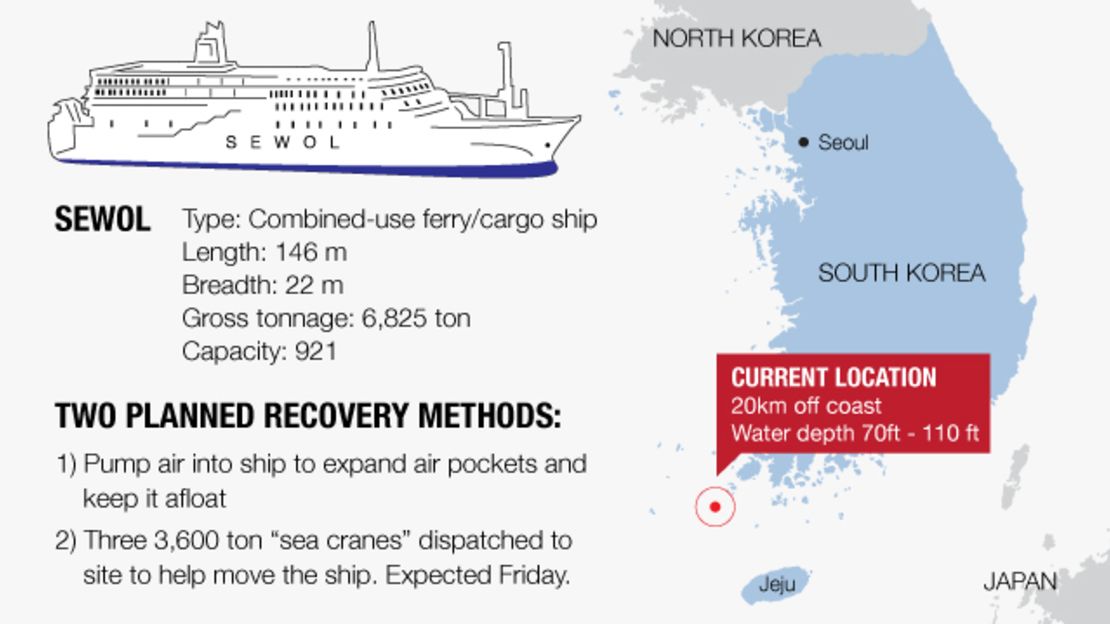Story highlights
Passengers who get to an air pocket may still have a shot
Nigerian Harrison Okene's remarkable story of survival highlights that
He survived 60 hours in a tiny air bubble, where he'd taken shelter last year
As rescuers take on the daunting task of finding survivors, family members of the missing passengers are pinning slim hopes on floundering air pockets in the capsized South Korean ferry.
They know the odds aren’t in their favor, particularly after the entire ferry went underwater Friday. But they point to one especially miraculous tale of survival for their reason for not giving up.
In May 2013, a tug boat carrying a 12-person crew capsized off the coast of Nigeria. Two divers sent to recover the bodies assumed everyone aboard had died. After all, the boat was about 100 feet down under the Atlantic Ocean.
Three days had passed. And when a diver reached for a hand he thought belonged to a corpse, he discovered it was Harrison Okene, the boat’s cook.
Okene had survived 60 hours in a 4-foot space – a tiny air bubble – where he’d taken shelter.
“The rest of my life is not enough to thank God for this wonder, it is incredible,” he told a local newspaper at the time.

Some have also pointed to the Italian cruise ship Costa Concordia, which ran aground and capsized in January 2012, killing dozens. Some survivors were pulled out after being trapped inside the ship for more than 30 hours.
Anguish over sinking amplified by misinformation
Comparing the incidents
Do those parallels apply to South Korean ferry, Sewol?
In the case of the Costa Concordia, the cruise ship was not fully submerged. Sewol is.
As for air pockets, also known as “voids,” they could provide those on board with a chance of survival, said maritime expert Kim Petersen said.
“It’s difficult to say since we don’t know the cause of the vessel sinking,” he said. “If it had been because of a problem with one of the vehicle doors, of course that could cause massive flooding very quickly and reduce the likelihood of voids.
“But the fact is that this is a vessel that is almost 500 feet in length and it’s sitting in waters that we believe to be between 70 and 110 feet deep, so there is the strong possibility that there are voids and the possibility of survivors.”
Potential air pockets offer hope
Many caveats
Trapped passengers, if there are any, also have to think ahead.
“When they’re in a small compartment … with an air bubble, they really have to stay calm and breathe shallow and conserve the oxygen in that space,” former Navy diver Bobbie Scholley told CNN.
However, Petersen warned that the effort to reach those trapped in potential voids will not be easy.
“The problem now is getting divers down into those areas and bringing those people to the surface,” he said.
Divers must contend with fierce winds and rough waters.
“There are heavy currents in the area. So the vessel itself is not stable in the water. So you are, by default, putting divers at risk,” U.S. Navy Capt. Heidi Agle told CNN’s Wolf Blitzer. The U.S. Navy is assisting with the South Korean search.
The frigid waters
Then, there’s the temperature.
The water is a frigid 50 F (10 C). At that temperature, exhaustion sets in within one to two hours. And the expected survival time is no more than six hours, CNN meteorologist Samantha Mohr said.
Still, rescue teams continued to pump air into the hull of the submerged ship Friday. Like the family members, they aren’t ready to give up yet.
READ: Woman, 71, survives because stranger wouldn’t give up on her
READ: Fake survivor posts add to nation’s anguish
READ: Seaborne cranes called in as relatives fear end to ferry rescue operation
CNN’s Euan McKirdy contributed to this report.






